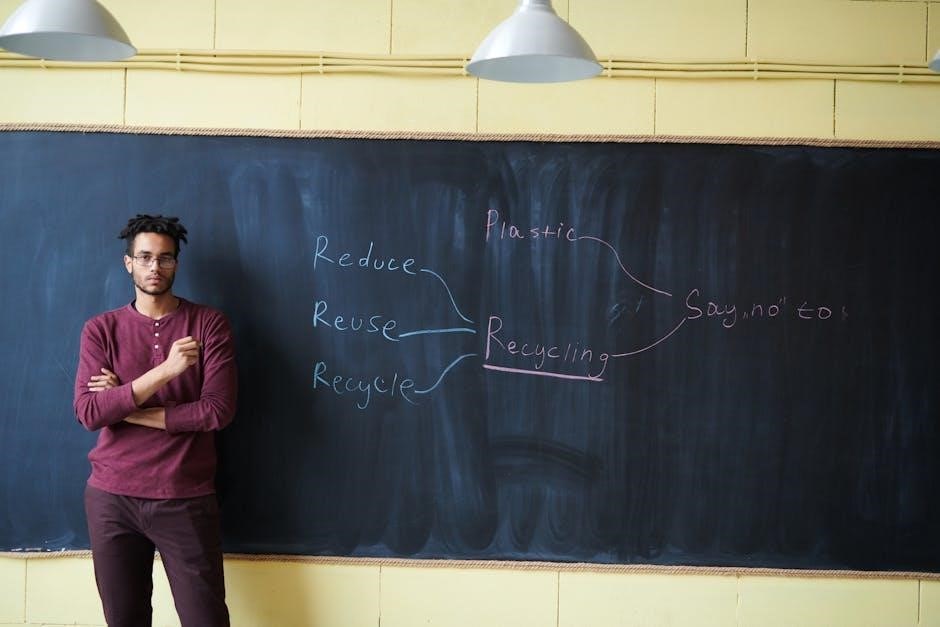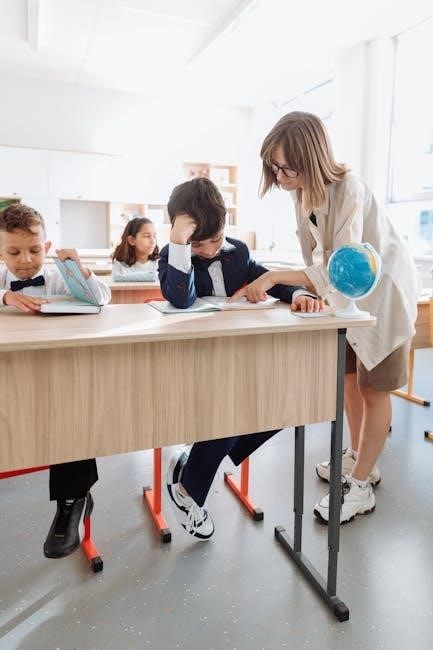Teacher-led instruction is a traditional educational approach where educators guide learning through structured lessons, expertise sharing, and interactive engagement, fostering understanding and critical thinking effectively.
Definition and Overview
Teacher-led instruction refers to a traditional educational approach where teachers actively guide and direct student learning through structured lessons and expert knowledge sharing. In this model, educators design and deliver content, often using standardized methods to ensure clarity and coherence. It emphasizes the teacher’s role in explaining concepts, demonstrating skills, and providing feedback, fostering a structured learning environment. This approach contrasts with student-centered methods, focusing on the teacher’s expertise to facilitate understanding and mastery of curriculum objectives effectively.
Importance of Teacher-Led Instruction in Education
Teacher-led instruction plays a vital role in education by ensuring structured, expert-driven guidance, enabling students to grasp complex concepts effectively. It allows teachers to tailor lessons to diverse learners, providing personalized support and maintaining academic rigor. This approach fosters accountability, as educators can closely monitor progress and address gaps in understanding. By leveraging their expertise, teachers create engaging and meaningful learning experiences, ultimately enhancing student outcomes and preparing learners for future challenges in an organized and impactful manner.
Historical Context and Evolution
Teacher-led instruction traces its roots to ancient educational systems, where sages and scholars imparted knowledge through lectures and discussions. Over centuries, this method evolved with advancements in pedagogy, integrating new techniques while retaining its core emphasis on teacher expertise. The Industrial Revolution brought standardized curricula, solidifying teacher-led approaches. Modern education continues this tradition, blending traditional methods with technology and inclusive practices, ensuring it remains adaptable to changing educational demands and diverse student needs, maintaining its effectiveness across generations as a cornerstone of formal learning.

Key Components of Teacher-Led Instruction
Teacher-led instruction involves structured lesson planning, teacher expertise, and active engagement, ensuring clear content delivery, classroom management, and tailored guidance to meet diverse student learning needs effectively.
Role of the Teacher in Classroom Management
In teacher-led instruction, the teacher plays a central role in classroom management by establishing clear rules, routines, and expectations. They maintain order, ensure student engagement, and address behavioral challenges promptly. Effective classroom management enables teachers to create a respectful and focused learning environment, minimizing disruptions and maximizing instructional time. By asserting authority and providing consistent guidance, teachers help students develop self-discipline and responsibility. This structured approach ensures that all students can participate actively and benefit from the lesson, fostering a positive and productive classroom atmosphere conducive to learning and academic success.
Structured Lesson Planning and Delivery
Structured lesson planning and delivery are cornerstone of teacher-led instruction, ensuring educational goals are met effectively. Teachers design organized, objective-driven lessons, incorporating clear timelines and resource allocation. Delivery involves presenting content methodically, often using visual aids, hands-on activities, and guided practice. This structured approach helps students grasp concepts sequentially, building upon prior knowledge. By aligning lessons with curriculum standards and diverse learning needs, teachers ensure comprehensive understanding and engagement. Effective delivery fosters a logical flow of ideas, enabling students to connect new information with existing knowledge seamlessly, thus enhancing retention and academic performance significantly in a focused learning environment.
Use of Instructional Strategies and Techniques
Teacher-led instruction employs diverse instructional strategies to cater to varied learning styles and enhance student engagement. Techniques like differentiated instruction, group work, and hands-on activities promote active participation. Teachers incorporate digital tools, multimedia resources, and formative assessments to monitor progress and adapt lessons dynamically. The integration of AI and educational software further personalizes learning experiences, offering tailored support to students. By balancing traditional methods with innovative approaches, educators create a structured yet flexible environment that fosters critical thinking, creativity, and problem-solving skills, ensuring comprehensive understanding and academic growth for all learners in an inclusive and supportive classroom setting.

Benefits of Teacher-Led Instruction
Teacher-led instruction leverages diverse strategies to maximize student engagement and understanding. Techniques include differentiated instruction, hands-on activities, and technology integration, fostering active learning environments. Educators employ formative assessments to monitor progress and tailor lessons, ensuring personalized support. The use of digital tools and AI-driven resources enhances engagement while catering to varied learning styles. By incorporating these strategies, teachers create structured yet dynamic classrooms, promoting critical thinking, creativity, and academic growth in a supportive and inclusive setting.
Improved Student Engagement and Focus
Teacher-led instruction enhances student engagement through structured, interactive lessons that cater to diverse learning styles. By actively guiding discussions, teachers maintain students’ attention and encourage participation. Clear expectations and real-time feedback foster a focused learning environment. Interactive activities, such as group work and hands-on tasks, keep students motivated. The teacher’s ability to adapt lessons ensures relevance, increasing students’ interest and involvement. This approach also promotes better time management, allowing students to concentrate on key concepts without distractions, ultimately leading to improved academic outcomes and a more dynamic classroom experience.
Enhanced Knowledge Retention and Understanding
Teacher-led instruction significantly boosts knowledge retention by providing clear, organized lessons that break down complex concepts. Teachers can address misunderstandings immediately, reinforcing learning through repetition and elaboration. Structured lessons ensure that students build a strong foundation, which enhances long-term retention. Interactive discussions and hands-on activities deepen understanding, making abstract ideas more tangible. The ability to tailor explanations to students’ needs ensures that each learner grasps the material effectively. This targeted approach not only improves retention but also fosters a deeper comprehension of the subject matter, preparing students for future academic challenges.
Personalized Learning Opportunities
Teacher-led instruction allows for personalized learning by enabling educators to adapt content and strategies to meet individual needs. Through one-on-one interactions and differentiated instruction, teachers can identify and address learning gaps, ensuring each student progresses effectively. Tailored feedback and pacing accommodate diverse learning styles, fostering a more inclusive classroom environment. This personalized approach enhances engagement and motivation, as students feel their unique needs are acknowledged and supported. By catering to individual differences, teacher-led instruction maximizes learning potential and helps students achieve their academic goals more efficiently.

Challenges in Implementing Teacher-Led Instruction
Teacher-led instruction faces challenges such as managing diverse classroom dynamics, ensuring equitable engagement, and balancing curriculum demands with individual student needs, requiring adaptive teaching strategies and time efficiency.
Classroom Management and Student Discipline
Classroom management and student discipline are critical challenges in teacher-led instruction. Maintaining a focused learning environment requires effective strategies to address behavioral issues and ensure student engagement. Teachers must balance authoritative roles with empathetic approaches to foster respect and order. Consistent rules, clear communication, and positive reinforcement are essential tools. Additionally, managing diverse student needs and minimizing disruptions while delivering content demands high levels of patience and adaptability. Successful classroom management enables teachers to create a productive and respectful space, ensuring academic goals are met and students thrive socially and academically;
Differentiated Instruction for Diverse Learners
Differentiated instruction in teacher-led classrooms involves tailoring teaching methods to meet the unique needs of diverse learners. Teachers identify varying abilities, learning styles, and cultural backgrounds through assessments and observations. They adapt content, processes, and products to ensure all students can engage meaningfully. Strategies like tiered assignments, flexible grouping, and personalized learning plans promote equity and inclusivity. This approach fosters a supportive environment where every student, regardless of their background or ability, can thrive academically and socially. However, implementing differentiated instruction requires careful planning and resources, presenting a challenge for educators striving to meet diverse needs effectively.
Time Management and Curriculum Coverage
Effective time management is crucial for comprehensive curriculum coverage in teacher-led instruction. Educators must allocate time wisely to ensure all essential topics are addressed without rushing or omitting key concepts. Structured lesson planning helps balance depth and breadth, while pacing guides maintain consistency across the academic year. However, unexpected disruptions and varying student paces often challenge teachers, requiring adaptable strategies to stay on track. Balancing thorough instruction with time efficiency is a constant dilemma, as educators strive to cover the curriculum comprehensively while meeting individual student needs and institutional expectations effectively.

Technology Integration in Teacher-Led Instruction
Technology integration enhances teacher-led instruction by utilizing digital tools, AI, and educational software to create engaging, interactive lessons, fostering deeper student understanding and participation in the learning process.
Use of Digital Tools for Engaging Lessons
Digital tools such as multimedia presentations, interactive simulations, and virtual labs enhance teacher-led instruction by creating immersive learning experiences. These tools allow teachers to present complex concepts in engaging ways, fostering student participation and understanding. Interactive whiteboards and online collaboration platforms enable real-time interaction, making lessons dynamic and inclusive. Additionally, educational software and apps provide personalized learning opportunities, catering to diverse student needs. The integration of AI-powered tools offers tailored feedback and adaptive learning paths, further enriching the instructional process. By leveraging these technologies, educators can create engaging, interactive, and effective lessons that captivate students and promote deeper learning outcomes.
Role of AI and Educational Software
AI and educational software play a transformative role in teacher-led instruction by providing personalized learning experiences and automating administrative tasks. AI-driven tools analyze student performance, offering tailored recommendations and adaptive learning paths. Educational software enhances lesson delivery through interactive content and real-time assessments, enabling teachers to track progress and identify learning gaps. These technologies also facilitate data-driven decision-making, allowing educators to refine their instructional strategies. By integrating AI and educational software, teachers can create more efficient and effective learning environments that cater to individual student needs while maintaining the human element of instruction. This synergy enhances both teaching and learning outcomes significantly.
Best Practices for Technology Integration
Effective technology integration in teacher-led instruction involves aligning digital tools with learning objectives, ensuring accessibility, and promoting collaboration. Teachers should choose tools that complement their pedagogical strategies, providing clear instructions and technical support to students. Regular training and professional development are essential to enhance educators’ digital literacy. Integrating technology should encourage active participation, such as through interactive simulations or collaborative projects, while maintaining a balance with traditional methods to avoid over-reliance on screens. By thoughtfully selecting and implementing technology, teachers can create engaging, inclusive, and dynamic learning experiences that enrich student engagement and understanding.

Assessment and Evaluation in Teacher-Led Instruction
Assessment and evaluation in teacher-led instruction involve using formative and summative methods to measure student progress, guide instruction, and ensure alignment with learning objectives and outcomes effectively.
Formative Assessment Techniques
Formative assessment techniques are strategies used by teachers to monitor student learning during lessons. These include quizzes, class discussions, exit tickets, and verbal feedback, providing immediate insights into student understanding. By identifying knowledge gaps and misconceptions, teachers can adjust instruction to meet student needs. Formative assessments also encourage active participation and engagement, helping students reflect on their own learning. These methods are essential for informal, ongoing evaluation, allowing educators to refine teaching strategies and ensure students stay on track toward achieving learning objectives effectively and dynamically throughout the instructional process.
Summative Assessment Methods
Summative assessments measure student learning at the end of an instructional period, such as a unit or term. These methods include tests, final projects, and portfolios. They evaluate mastery of learning objectives and provide a comprehensive overview of student achievement. Summative assessments help teachers determine grades and identify long-term learning outcomes. They also allow for reflection on the effectiveness of instruction and inform future teaching strategies. By providing clear, measurable results, summative assessments play a crucial role in tracking student progress and accountability in teacher-led instruction, ensuring educational goals are met effectively and consistently over time.
Data-Driven Instructional Decisions
Data-driven instructional decisions involve using assessment results and learning analytics to guide teaching strategies. Teachers analyze student performance data to identify strengths, weaknesses, and learning gaps. This information helps tailor lessons, differentiate instruction, and allocate resources effectively. By leveraging data, educators can make informed decisions that enhance student outcomes and improve the overall quality of instruction. Regular monitoring of progress ensures that teaching methods remain aligned with learning objectives, fostering a more adaptive and responsive educational environment. This approach promotes accountability and continuous improvement in teacher-led classrooms, ultimately benefiting student success and academic achievement.

Cultural and Inclusive Considerations
Cultural and inclusive considerations in teacher-led instruction emphasize creating a welcoming environment for diverse learners, addressing cultural backgrounds, and promoting equity in education through tailored practices and resources.
Teaching in Culturally Diverse Classrooms
Teaching in culturally diverse classrooms requires educators to adapt their practices to meet the needs of students from varied cultural backgrounds. This involves creating an inclusive environment where all students feel valued and respected. Teachers can achieve this by incorporating diverse perspectives into lesson plans, using culturally responsive teaching strategies, and being mindful of potential cultural biases. Effective communication and collaboration among students from different backgrounds can also be fostered through group work and interactive activities. By embracing diversity, teachers can enhance student engagement, promote cross-cultural understanding, and ensure equitable learning opportunities for all. This approach enriches the classroom experience and supports academic success.
Inclusive Education Practices
Inclusive education practices ensure all students, regardless of ability, culture, or background, can fully participate and succeed. Teachers use strategies like differentiated instruction, universal design for learning, and assistive technologies to meet diverse needs. Collaboration with specialists, such as special education teachers, enhances support for learners with disabilities. Flexible grouping and scaffolding techniques create accessible learning pathways. Culturally responsive teaching bridges students’ backgrounds with curriculum content, fostering engagement. Additionally, inclusive practices promote social inclusion, encouraging interaction among diverse peers. By addressing individual needs and providing equitable opportunities, teachers create a supportive environment where all students thrive academically and socially.
Culturally Responsive Teaching Strategies
Culturally responsive teaching strategies involve connecting students’ cultural backgrounds to the curriculum, fostering engagement and understanding. Teachers incorporate diverse texts, images, and materials that reflect students’ identities, promoting a sense of belonging. They also integrate cultural knowledge into lessons, making learning relevant and meaningful. Encouraging student voice and experiences enriches classroom discussions, while addressing implicit biases ensures equitable interactions. Professional development helps educators develop cultural awareness and adapt practices to meet diverse needs. These strategies create an inclusive environment where students feel valued and empowered to succeed academically and socially.

Professional Development for Teachers
Professional development enhances teachers’ skills through workshops, training, and mentorship, fostering continuous learning and adapting to evolving educational trends and methodologies for improved instructional effectiveness and student outcomes.
Continuous Learning and Skill Enhancement
Continuous learning and skill enhancement are essential for teachers to stay updated with evolving educational trends and methodologies. Through workshops, training programs, and mentorship, educators refine their instructional strategies and adapt to new technologies. This ongoing professional development ensures teachers remain effective in delivering high-quality instruction, addressing diverse student needs, and fostering academic success. By engaging in lifelong learning, teachers not only enhance their expertise but also model the importance of education for their students, creating a culture of growth and innovation in the classroom.
Workshops and Training Programs
Workshops and training programs play a vital role in equipping teachers with innovative instructional techniques and tools. These sessions provide hands-on experiences, allowing educators to explore new strategies and technologies. By focusing on specific areas like classroom management, differentiated instruction, and technology integration, workshops ensure teachers are well-prepared to meet diverse student needs. Training programs often include collaborative activities, fostering peer learning and the exchange of best practices. Such professional development opportunities are crucial for maintaining high standards of teacher-led instruction and enhancing overall educational outcomes.
Mentorship and Peer Support
Mentorship and peer support are essential for fostering professional growth among teachers, particularly in teacher-led instruction. Experienced educators guide less experienced colleagues, sharing strategies and best practices to enhance instructional effectiveness. Peer support encourages collaboration, creating a network where teachers can share ideas, address challenges, and refine their teaching methods. These relationships not only strengthen teaching skills but also promote a culture of continuous improvement. By leveraging collective expertise, teachers can adapt to evolving educational demands, ensuring high-quality instruction and better student outcomes through collaborative problem-solving and shared knowledge.

Parent-Teacher Collaboration
Effective parent-teacher collaboration enhances learning by fostering open communication, shared goals, and active involvement, creating a supportive environment that promotes student success and overall educational growth.
Communication Strategies for Effective Collaboration
Effective communication is the cornerstone of successful parent-teacher collaboration. Regular updates through emails, newsletters, or parent-teacher portals ensure transparency and keep parents informed about their child’s progress. Active listening and clear messaging help build trust and understanding. Scheduling regular meetings and being approachable fosters open dialogue, allowing both parties to share insights and concerns. Additionally, incorporating technology tools, such as video conferencing or messaging apps, can enhance accessibility and convenience. By maintaining consistent and respectful communication, educators and parents can work together seamlessly to support student learning and development.
Parental Involvement in Learning Process
Parental involvement in the learning process is crucial for student success. When parents actively engage with their child’s education, it fosters a supportive environment that enhances academic performance and motivation. This involvement can take many forms, such as assisting with homework, participating in parent-teacher meetings, or volunteering in classrooms. By staying informed about their child’s progress and maintaining open communication with teachers, parents can provide tailored support. Encouraging parents to set expectations and celebrate achievements reinforces the importance of education. Collaborative efforts between parents and educators create a cohesive learning experience, ensuring students feel supported both at home and in school.
Building a Supportive Learning Environment
Building a supportive learning environment requires collaboration between teachers, students, and parents. By fostering mutual respect and open communication, educators can create a positive space where students feel comfortable exploring ideas and taking risks. Teachers can encourage active participation by incorporating diverse perspectives and ensuring inclusivity. Parents play a vital role by reinforcing learning at home and maintaining consistent expectations. Together, these efforts cultivate a culture of trust and collaboration, enabling students to thrive academically and socially. A supportive environment not only enhances learning but also nurtures emotional growth and resilience in students.

Future of Teacher-Led Instruction
Teacher-led instruction will evolve with technology, integrating AI tools and hybrid learning models, while maintaining the core value of personalized, human-centered education for future generations.
Emerging Trends and Innovations
Emerging trends in teacher-led instruction include the integration of AI-powered tools, personalized learning platforms, and hybrid learning models. These innovations enhance engagement, cater to diverse learning styles, and provide real-time feedback. Educators are increasingly adopting adaptive technologies to tailor lessons to individual needs, while data-driven insights enable more informed instructional decisions. Additionally, the rise of collaborative digital spaces and virtual classrooms is reshaping how teachers deliver content and interact with students. These advancements not only modernize education but also empower teachers to create dynamic, inclusive, and effective learning environments for the future.
Hybrid Learning Models
Hybrid learning models blend traditional face-to-face instruction with digital learning, offering flexibility and adaptability. Teachers can alternate between in-person and online activities, using structured lesson plans to ensure continuity. This approach allows for personalized learning experiences, where students can engage with content at their own pace. Digital tools enhance interaction, enabling real-time feedback and collaborative projects. Hybrid models also accommodate diverse learning needs, fostering inclusivity and equity. By integrating technology, teachers can create dynamic, engaging, and effective learning environments that cater to modern educational demands while maintaining the core benefits of teacher-led instruction.
Adapting to Changing Educational Landscapes
Teacher-led instruction must evolve to meet the demands of a rapidly changing educational landscape. With advancements in technology and shifting student needs, educators are incorporating innovative tools and methods while maintaining structured guidance. Hybrid learning models and digital resources are being integrated into traditional teaching practices, allowing for flexibility and personalized learning experiences. Teachers are adapting by embracing professional development opportunities to enhance their skills in using AI, educational software, and online platforms. This evolution ensures that teacher-led instruction remains relevant, effective, and responsive to the diverse needs of modern learners in an ever-changing world.
